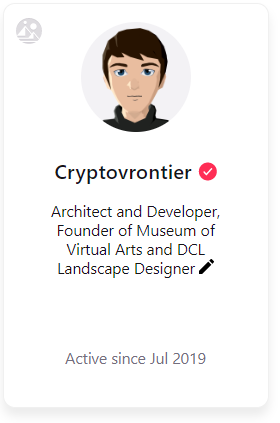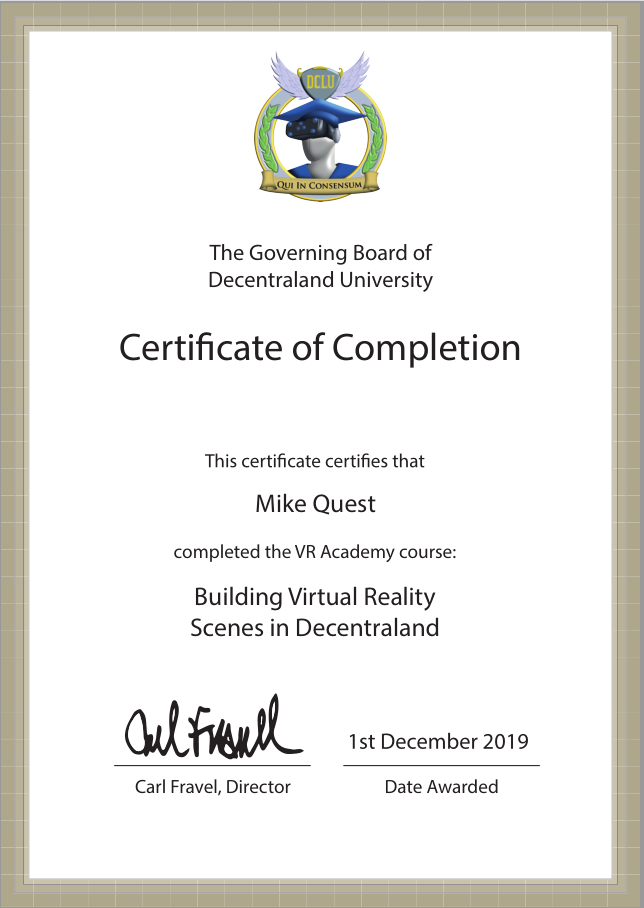

Building in Decentraland
Decentraland University
My Activities in Decentraland
I joined Decentraland’s Virtual Reality as land owner and district contributor and started using its software development kit (SDK) for my projects. Besides the joy of creating virtual structures from code - Building as Code - it is Decentraland’s community that makes working in this new space so exciting. A vivid exchange with lots of LOL including a direct link to the development team is taking place almost 24-7 on Decentraland’s Discord.
Below is a brief description of the two main projects I am working on right now and a few pointers for those interested in building in this new world.
MoVA, the Museum of Virtual Arts, Aetheria
The purpose of this project is to build the Museum of Virtual Arts in Aetheria, one of Decentraland’s districts. It will exhibit artworks that can be experienced by anyone and anybot. The project aims to establish a set of ateliers in which Aetherian artists can work plus a gallery for the acquisition of virtual artworks.
The museum is Building as Code and includes not only the museum structure but also a set of interactive entities, e.g. elevators. The code is an open source library so that everyone interested can re-use and customise it to their own project need. The code can be retrieved from the MoVA repository on GitHub.
Programmed Landscapes
Programmed Landscapes is a libray that helps builders develop larger land plots by positioning entities, e.g. glTF models in well-defined 2D grid layers. Once layer dimensions and grid size have been defined, models can be placed straight-forward by simply setting their relative position, rotation and scaling. Layers themselves can be positioned, rotated and scaled as well. Layers can be combined with each other so that different needs can be adressed, e.g. larger and smaller grid cell sizes or different levels of height. The positioning of entities in a grid cell can be randomized so that more natural onfigurations like forests can be achieved.
The library was created together with Ile, who created the architecture modules as glTF, as our contribution to the June 2019 Decentraland Hackathon. It is open source and its code can be retrieved from the DCL Landscapes repository on GitHub.
Building in Decentraland
Today, two ways of building in Decentraland exist: you either can use the official builder which does not require programming skills or you can use the SDK like I do in the projects mentioned above. Decentraland documentation explaining key concepts and programmable SDK can be found on the Decentraland documentation site. For the SDK it is beneficial to have some software development experience but you can also jump right into it by learning TypeScript, its programming language, which is relatively easy to get familiar with. The TypeScript language site offers tutorials and samples and can be used as starting point. Further useful skills include the usage of 3D modeling software being capable of exporting glTF 2.0 models, e.g. Blender to name an open source one.
The best way to learn how-to build is taking Carl Fravel’s Decentraland University VR Academy course “Building in Decentraland”. The course took place Aug-Sep 2019 but you can access its recorded lessons on the Decentraland University Youtube channel and its course materials on Google. Carl is one of the founders of Decentraland University and a member of its board and faculty.
The course is a well-paced walk through Decentraland technologies, useful building tools, the SDK itself and working with 3D modelling software like Blender to create glTF models for Decentraland. It is peppered with lots of tips and tricks. You may want to join the Decentraland University Discord for further inquiries.